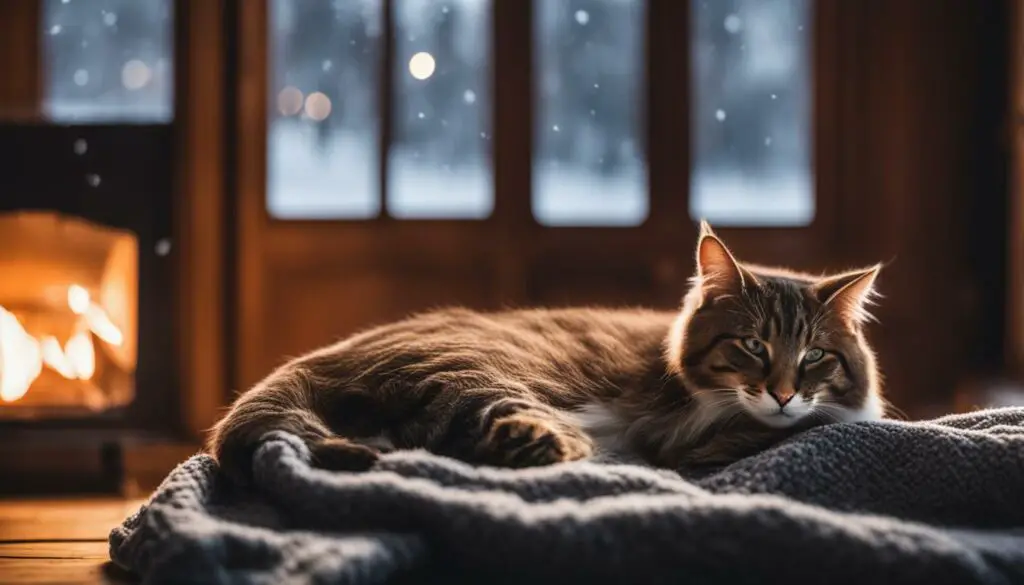As a cat owner, I understand the importance of creating a comfortable and cozy environment for our feline friends, especially during the chilly winter months. One crucial aspect of ensuring our cats’ well-being is maintaining the perfect house temperature. In this guide, I will share valuable insights on the ideal home temperature for cats in winter, helping you keep your furry companion happy and warm.
Key Takeaways:
- Providing a safe temperature indoors is essential for cats to avoid hypothermia.
- Cats’ sensitivity to temperature varies, but most cats find 70 degrees Fahrenheit comfortable.
- Maintain a warm house temperature and consider additional warming options such as heated beds.
- A nutritious diet and proper grooming promote a healthy winter coat for insulation.
- Individual factors, including breed, size, and health condition, affect cats’ temperature tolerance.
Understanding Cats’ Sensitivity to Temperature
I am often asked about cats’ sensitivity to temperature, as pet owners want to ensure their furry friends are comfortable and safe. It’s important to understand that cats have different temperature needs compared to humans. While their body temperatures range from 100.5 to 102.5 degrees Fahrenheit, their fur alone is not enough to withstand harsh temperatures. Cats need a safe temperature of at least 50 degrees Fahrenheit indoors to avoid hypothermia.
There are several signs that your cat may be too cold. These include curling up tightly, seeking warmth from you more than usual, shivering, and having cold paws, ears, and tail. If you notice any of these signs, it’s essential to provide your cat with a warmer environment. Cats are sensitive to temperature changes, so maintaining a consistent and comfortable indoor temperature is key to their well-being.
Cat temperature regulation is also influenced by external factors such as breed, age, size, and health condition. Long-haired cats generally tolerate cooler temperatures better than short-haired cats. Kittens and older cats require warmer temperatures than adult cats. Smaller cats and those with low body fat have less capacity to retain heat. Cats with certain health conditions may have specific temperature preferences. It’s crucial to consider these factors and provide the ideal temperature for your cat’s unique needs.
Understanding Cats’ Sensitivity to Temperature
| External Factors | Temperature Sensitivity |
|---|---|
| Breed | Long-haired cats tolerate cooler temperatures better than short-haired cats. |
| Age | Kittens and older cats require warmer temperatures than adult cats. |
| Size | Smaller cats and those with low body fat have less capacity to retain heat. |
| Health Condition | Cats with certain health conditions may have specific temperature preferences. |
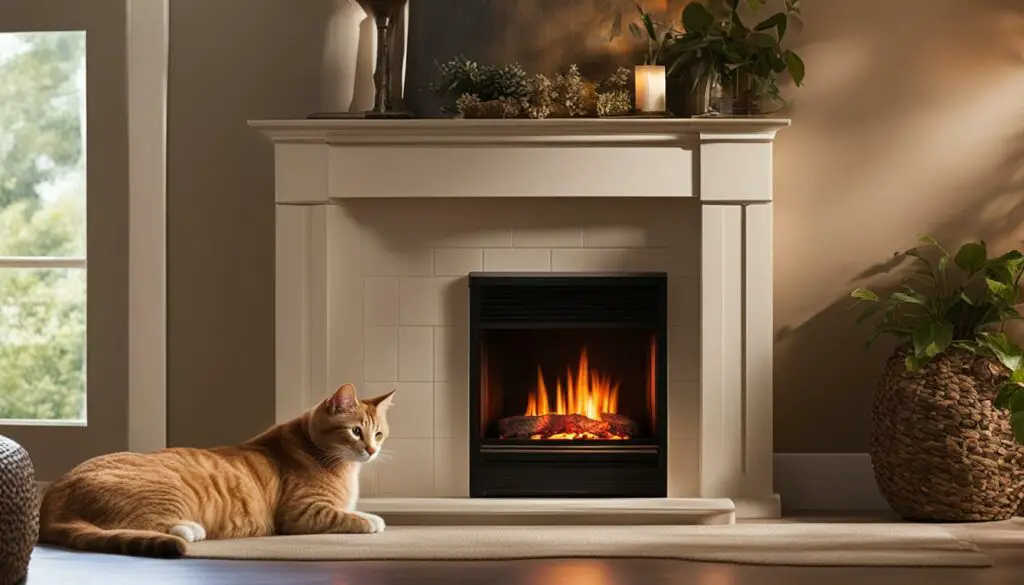
Understanding cats’ sensitivity to temperature is crucial for providing them with a comfortable living environment. It’s essential to monitor your cat’s behavior and adjust the temperature accordingly to ensure they are happy and healthy. By creating a warm and cozy indoor space for your cat, you can help them thrive during the cold winter months.
Keeping Your Cat Warm and Cozy Indoors
During the winter months, it’s important to ensure that your cat stays warm and comfortable indoors. There are several cat heating options and warming strategies you can employ to keep your furry friend cozy throughout the colder season.
1. Maintain a Warm House Temperature
One of the easiest ways to keep your cat warm is by maintaining a warm house temperature. Check your heating system to ensure it is accurate and reliable. Focus on heating the rooms where your cat spends the most time, while allowing the rest of the house to be cooler to save energy.
2. Provide a Cozy Sleeping Area
Your cat will appreciate having a warm and cozy sleeping area where they can curl up and relax. Place a soft blanket or cat bed in a warm spot near a window or heater. This will provide extra warmth and comfort for your feline companion. Consider investing in a heated cat bed, especially for older cats or those with arthritis, as it can provide additional therapeutic benefits.
3. Additional Cat Warming Options
If you want to go the extra mile in keeping your cat warm, there are several additional cat warming options available. For instance, you can use a heated pad or blanket specifically designed for cats. These products emit a gentle heat that can be a soothing source of warmth for your cat. Just make sure to follow the manufacturer’s instructions and never leave these products unattended.

4. Catering to Individual Preferences
It’s important to remember that all cats have different preferences when it comes to warmth. While some cats may prefer a cozy and warm environment, others may prefer a cooler spot. Pay attention to your cat’s behavior and observe whether they seek out warm areas or prefer cooler spots. This will help you determine the best cat warming options for your feline friend.
By implementing these cat heating options and warming strategies, you can ensure that your cat stays warm and comfortable throughout the winter months. Remember, a happy and cozy cat is a healthy and content cat!
Catering to Your Cat’s Diet for Winter Coat Growth
Proper nutrition is essential for your cat’s overall health and well-being, including the development of a thick and healthy winter coat. During the colder months, it’s important to provide your feline friend with a balanced and nutrient-rich diet to support coat growth and maintenance.
When it comes to cat nutrition for winter, there are a few key factors to consider. Firstly, ensure that your cat’s diet meets their specific needs and provides all the necessary vitamins and minerals. A high-quality cat food that is rich in protein and fats can help promote a healthy and vibrant coat. Look for cat foods that contain omega-3 fatty acids, as these can contribute to coat health and reduce shedding.
In addition to a well-rounded diet, you may want to consider supplements to support your cat’s winter coat growth. Omega-3 fatty acid supplements, such as fish oil, can provide an extra boost to your cat’s coat health. These supplements can help reduce itching and inflammation, resulting in a softer and shinier coat. However, it’s always best to consult with your veterinarian before adding any supplements to your cat’s diet.
Table: Essential Nutrients for a Healthy Winter Coat
| Nutrient | Food Sources |
|---|---|
| Protein | Chicken, turkey, fish |
| Fats | Salmon oil, flaxseed oil |
| Omega-3 Fatty Acids | Fish oil, sardines |
| Vitamin E | Spinach, sunflower seeds |
| Vitamin A | Liver, carrots |
Remember to always provide fresh water for your cat, as hydration is crucial for overall health and maintaining a healthy coat. Additionally, regular grooming can help stimulate blood flow to the skin and distribute natural oils, keeping the coat in optimal condition. By ensuring a balanced diet and proper grooming, you can help your cat develop a lush and beautiful winter coat.
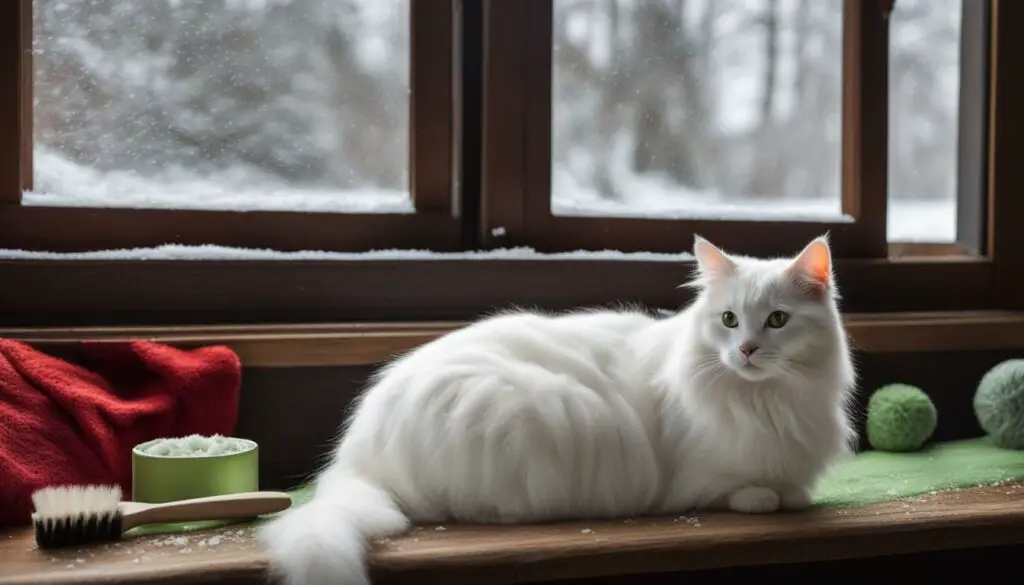
Understanding Factors Affecting Cats’ Temperature Tolerance
Cats, like humans, have varying temperature tolerances based on several factors. These factors include breed, age, size, and health condition. Understanding these factors can help us create a comfortable environment for our feline friends during different seasons.
Breed plays a significant role in a cat’s temperature tolerance. Long-haired breeds, such as the Maine Coon or Persian, tend to tolerate cooler temperatures better than short-haired breeds like the Siamese or Bengal. Their thick fur acts as insulation, providing them with additional warmth. On the other hand, short-haired breeds may require slightly higher indoor temperatures to stay comfortable during winter.
Age is another important factor to consider. Kittens have smaller bodies and less developed fat stores, making them more susceptible to the cold. Older cats, especially those with arthritis, may also have a reduced ability to regulate their body temperature. Therefore, it’s crucial to provide optimal warmth for these age groups.
The size and health condition of a cat can also affect its temperature tolerance. Smaller cats and those with low body fat have a harder time retaining heat, so they may require a warmer environment. Additionally, cats with certain health conditions, such as hypothyroidism or diabetes, may have specific temperature preferences. It’s essential to consult with a veterinarian to understand any unique needs your cat may have.
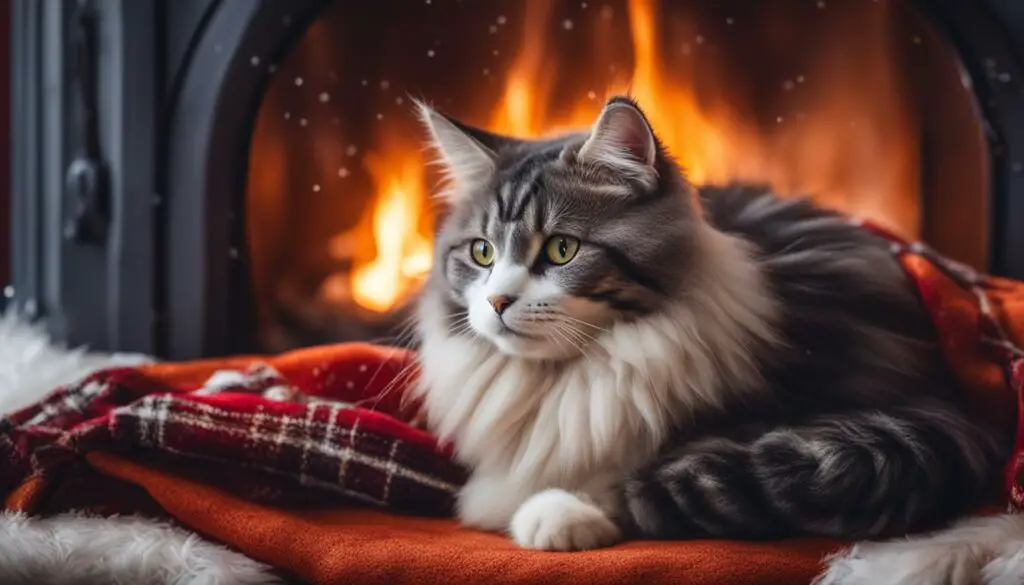
Factors Affecting Cats’ Temperature Tolerance:
- Breed: Long-haired breeds tolerate cooler temperatures better than short-haired breeds.
- Age: Kittens and older cats require warmer temperatures than adult cats.
- Size: Smaller cats have less capacity to retain heat and may require warmer environments.
- Health condition: Cats with certain health conditions may have specific temperature preferences.
In Summary:
Understanding the factors that affect a cat’s temperature tolerance allows us to create a comfortable and safe environment for them. Consider your cat’s breed, age, size, and health condition when determining the ideal temperature for them. Providing appropriate warmth and monitoring their behavior will ensure your feline companion stays cozy and content throughout the colder months.
| Factor | Effect on Temperature Tolerance |
|---|---|
| Breed | Long-haired breeds tolerate cooler temperatures better. |
| Age | Kittens and older cats require warmer temperatures. |
| Size | Smaller cats may require warmer environments. |
| Health condition | Cats with certain health conditions may have specific temperature preferences. |
Determining the Ideal Winter Temperature for Your Cat
When it comes to keeping your cat comfortable during the winter months, finding the ideal temperature is key. While there is no exact magic number, the ideal winter temperature for cats indoors typically ranges between 60 and 70 degrees Fahrenheit. However, it’s important to consider factors such as your cat’s breed, size, and overall health condition when determining the specific temperature.
Cats have different preferences when it comes to temperature, and their individual needs should be taken into account. Long-haired cats may prefer slightly cooler temperatures, as their thick coats provide insulation. On the other hand, small or short-haired cats may require warmer temperatures to stay comfortable. It’s essential to monitor your cat’s behavior and adjust the temperature accordingly to ensure their well-being.
Factors to Consider when Determining the Ideal Winter Temperature
Several factors can influence your cat’s ideal winter temperature. Consider the following factors when determining the perfect temperature for your feline friend:
- Breed: Some cat breeds, like the Maine Coon or Norwegian Forest Cat, have thick, insulating fur that allows them to tolerate cooler temperatures better.
- Size: Smaller cats may have a harder time retaining body heat, requiring warmer temperatures to stay comfortable.
- Health Condition: Cats with certain health conditions, such as arthritis or a weakened immune system, may benefit from a slightly warmer environment.

Remember, your cat’s comfort should be the top priority. Pay attention to their behavior and adjust the temperature as needed. If your cat is curling up tightly or seeking warmth excessively, it may be a sign that the temperature needs to be increased. Conversely, if your cat appears lethargic or seeks cooler spots, lowering the temperature slightly may be beneficial.
| Cat Breed | Ideal Winter Temperature |
|---|---|
| Maine Coon | 60-65 degrees Fahrenheit |
| Sphynx | 70-75 degrees Fahrenheit |
| Siamese | 65-70 degrees Fahrenheit |
Keep in mind that these temperature ranges are general guidelines and may vary depending on your cat’s individual preferences. By considering their specific needs, you can create a cat-friendly home temperature that keeps them cozy and content throughout the winter season.
Providing Comfortable Temperatures During Summer
During the summer months, it’s important to ensure that your cat stays cool and comfortable. Cats have a natural tolerance for warmer temperatures, given their desert ancestry, but it’s still essential to take certain measures to keep them safe and comfortable. The ideal room temperature for cats in summer typically ranges between 80 and 90 degrees Fahrenheit for long-haired or overweight cats, while short-haired or slim cats can tolerate temperatures up to 90 degrees Fahrenheit.
To help your cat stay cool, make sure you maintain proper air circulation in your home. Leave fans or windows open to allow fresh air to flow through. If your home tends to get particularly hot, consider using air conditioning or a portable cooling unit to create a more comfortable environment for your cat.
In addition to controlling the room temperature, there are other cooling options you can provide for your cat. Consider investing in a cooling pet bed, which can help regulate their body temperature and provide a comfortable place to rest. You can also create shaded areas in your home by positioning furniture or installing window coverings to block out direct sunlight. This will give your cat a cool spot to relax without direct exposure to the sun’s heat.
Keeping Your Cat Hydrated
Proper hydration is vital for cats, especially during the summer when they may be more prone to dehydration. Make sure your cat always has access to fresh, clean water. Consider placing multiple water bowls throughout your home to encourage drinking. You can also add ice cubes to your cat’s water bowl to provide an extra cooling effect. Some cats also enjoy drinking from a pet water fountain, which keeps the water flowing and fresh.
Conclusion
By maintaining a cat-friendly summer temperature, providing adequate air circulation, and offering cooling options, you can ensure that your cat stays comfortable and safe during the warmer months. Pay attention to signs of overheating, such as excessive panting, lethargy, or seeking cool surfaces to lie on. If you suspect your cat is overheated, provide them with a cool, quiet area and contact your veterinarian for further guidance. Remember, a happy and comfortable cat is a healthy cat.
Creating a Cat-Friendly Winter Environment

Creating a cat-friendly environment during winter is essential to ensure your feline friend stays comfortable and safe. By considering their temperature adaptation needs and providing warm and cool zones, you can create a harmonious home environment for your cat.
Warm Zones
Cats love to bask in the warmth of the sun, so providing high areas near windows or window perches can give them a cozy spot to enjoy the sun’s rays. Consider adding soft blankets or pillows to these areas to provide extra warmth and comfort.
Additionally, if your home has fully tiled floors, create warm zones by placing heated pet beds or blankets in areas where your cat likes to spend time. These warm spots offer a soothing retreat for your cat during colder months.
Cool Zones
While keeping your cat warm is important, it’s equally crucial to provide cool zones where your cat can escape the heat. Ensure easy access to shaded areas, such as a covered patio or a quiet corner with a fan, to help your cat stay comfortable when temperatures rise.
Consider keeping doors or windows open to promote air circulation and create a refreshing breeze throughout your home. This can help regulate the temperature and prevent your cat from overheating.
Additional Considerations
When creating a cat-friendly winter environment, it’s important to be mindful of potential hazards. Keep your cat away from open flames, such as those from heaters or fireplaces, to prevent burns or accidents.
Regularly groom your cat’s fur to maintain its insulation properties and keep it clean and healthy. This can help your cat better regulate their body temperature.
| Warm Zones | Cool Zones | Additional Considerations |
|---|---|---|
| Provide high areas near windows or window perches | Ensure easy access to shaded areas | Keep your cat away from open flames |
| Add soft blankets or pillows | Keep doors or windows open for air circulation | Regularly groom your cat’s fur |
| Place heated pet beds or blankets on tiled floors | Create a refreshing breeze in your home |
By analyzing your home for optimal temperature balance and considering your cat’s individual needs, you can create a cat-friendly winter environment that ensures their comfort and well-being.
Adjusting Temperature Based on Your Cat’s Individual Needs
When it comes to ensuring your cat’s comfort during winter, it’s important to consider their individual needs. While general temperature guidelines can be helpful, every cat is unique in their temperature preferences. By observing your cat’s behavior and comfort level, you can make adjustments to the temperature of your home to keep them happy and cozy.
When your cat is curling up tightly or seeking warmth excessively, it may be an indication that they are feeling cold. In this case, consider raising the temperature slightly to provide them with more warmth. You can also provide additional options such as a heated cat bed or a cozy blanket to help them stay comfortable.
On the other hand, if your cat appears lethargic or seeks cooler spots, it may be a sign that they are feeling too warm. Lowering the temperature slightly can help them find relief and maintain a comfortable body temperature. Providing access to shaded areas or placing a cooling mat in their favorite resting spot can also help them cool down.
Remember, your cat’s comfort should be prioritized. By paying attention to their behavior and making small adjustments, you can ensure that their environment is just right for them during the winter months.
Table: Signs of Temperature Discomfort in Cats
| Signs of Cold | Signs of Heat |
|---|---|
| Curling up tightly | Lethargy |
| Seeking warmth excessively | Seeking cooler spots |
| Shivering | Panting |
| Cold paws, ears, and tail | Restlessness |
Considering Safety Measures for Cats in Extreme Temperatures
When it comes to extreme temperatures, it’s essential to prioritize your cat’s safety and well-being. Both cold weather and hot weather can pose risks to your furry friend if proper precautions are not taken. Here are some safety measures to keep in mind:
Cat Safety in Cold Weather
In frigid temperatures, it’s crucial to provide your cat with a warm and sheltered environment. If you have an outdoor cat, consider bringing them indoors during cold spells or providing them with a well-insulated shelter. The shelter should be elevated off the ground and lined with blankets or straw for added warmth. Ensure your cat has access to fresh water at all times, as dehydration can still occur in cold weather.
Cat Safety in Hot Weather
During hot weather, it’s important to protect your cat from overheating. Provide shaded areas in your home or outdoor space where your cat can seek relief from the sun. Ensure proper ventilation to keep the air circulating and prevent heat buildup. Always provide fresh, cool water for your cat to stay hydrated. Never leave your cat in a car during hot weather, as temperatures can rise dangerously fast and put their life at risk.
| Cold Weather Safety | Hot Weather Safety | |
|---|---|---|
| 1 | Bring outdoor cats indoors or provide a well-insulated shelter | Provide shaded areas and proper ventilation |
| 2 | Ensure fresh water is always available | Offer fresh, cool water to prevent dehydration |
| 3 | Monitor your cat’s behavior for signs of discomfort | Prevent your cat from being left in a car |
Remember, extreme temperatures can be dangerous for cats, so it’s important to take appropriate measures to keep them safe and comfortable. By understanding their specific needs and providing a suitable environment, you can help your cat thrive all year round.
With these safety measures in mind, you can ensure that your cat is protected during extreme temperatures. Whether it’s braving the cold or staying cool in the heat, your furry companion will appreciate the care and attention you give to their well-being.
Tips for Traveling During Winter with Your Cat
Traveling with your cat during the winter months requires extra care and preparation to ensure their comfort and well-being. Whether you’re going on a road trip or taking a flight, keeping your cat warm during travel is essential. Here are some tips to help you make the journey as smooth and cozy as possible:
- Choose a suitable cat carrier: When traveling with your cat in winter, it’s important to select a carrier that provides insulation and proper ventilation. Look for carriers with soft bedding and secure closures to keep your cat safe and warm. Additionally, consider using a carrier cover or blanket to provide extra warmth and privacy.
- Dress your cat appropriately: Depending on the climate and duration of your journey, you may need to dress your cat in a sweater or jacket to keep them warm. Ensure that the clothing fits properly and does not restrict your cat’s movement or breathing. Always monitor your cat’s comfort level and remove any clothing if they seem uncomfortable.
- Keep the car interior temperature comfortable: When traveling by car, adjust the temperature to a comfortable level for your cat. Avoid extreme cold or heat that could make them uncomfortable or even jeopardize their health. Pay attention to your cat’s behavior during the trip and make necessary adjustments to the temperature if needed.
- Bring essential supplies: Pack extra blankets or bedding to provide additional warmth for your cat during travel. Carry portable heating pads or warm packs that can be safely used in the carrier. Don’t forget to bring enough food, water, and any necessary medications for your cat’s journey.
Remember to consult with your veterinarian before traveling to ensure that your cat is healthy and prepared for the journey. It’s also a good idea to acclimate your cat to the carrier and car travel beforehand, especially if they are not used to it. By taking these precautions and providing a comfortable travel environment, you can ensure that your cat stays warm and relaxed during winter trips.
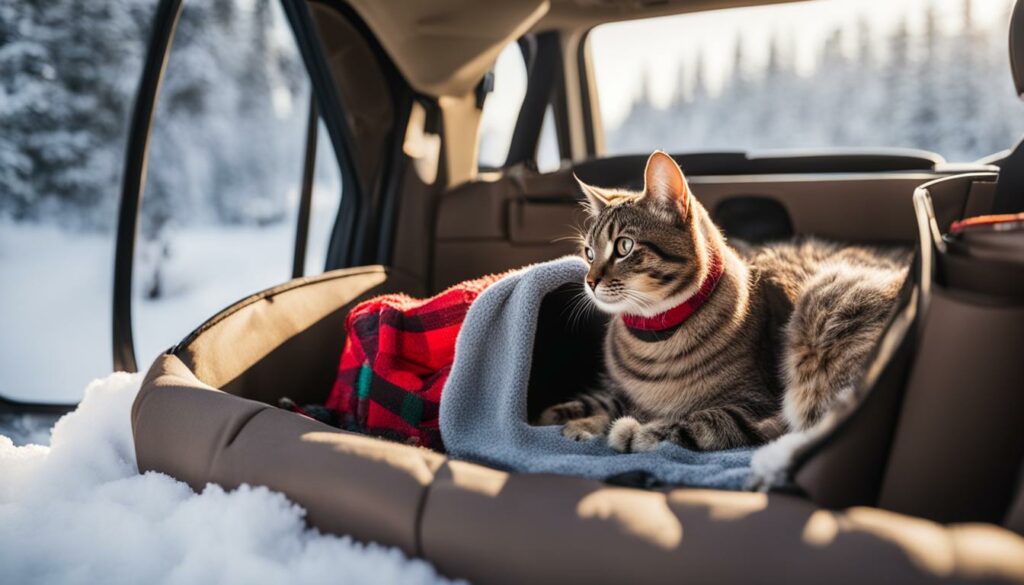
Quote:
“Traveling with a cat during winter can be a rewarding experience, but it requires careful planning and consideration for their well-being. By following these tips, you can ensure that your furry friend stays warm and comfortable during the journey.”
– Dr. Amanda Wright, DVM
| Essential Supplies for Winter Travel with Cats | Quantity |
|---|---|
| Carrier with proper insulation and ventilation | 1 |
| Soft bedding for the carrier | 1 or more |
| Sweater or jacket for extra warmth | 1 |
| Blankets or bedding for additional warmth | Extra |
| Portable heating pads or warm packs | 1 or more |
| Ample food and water supply | Sufficient for the duration of the journey |
| Medications or necessary treatments | As required |
Creating a Cat-Friendly Winter Environment
During the winter months, it’s important to create a cat-friendly environment that ensures your furry friend stays comfortable and safe. Here are some tips for making your home a cozy haven for your cat:
1. Provide Warm and Cozy Sleeping Areas
Cats love to curl up and snuggle in warm spots, especially during winter. Create comfortable sleeping areas by placing soft blankets or pillows near a window or heater. These cozy spots will give your cat a warm place to rest and provide them with a sense of security.
2. Keep Your Cat Mentally Stimulated
Indoor cats can become bored during the winter months when they have limited outdoor activities. To keep their minds active and engaged, provide interactive toys and scratching posts. These will not only prevent boredom but also help keep your cat physically active and mentally stimulated.
3. Protect Your Cat from Potential Hazards
Winter brings potential hazards that can harm your cat. Keep your cat away from open flames from heaters or fireplaces to prevent burns. Ensure that any electrical cords or decorations are safely secured to avoid accidental injuries. By eliminating these hazards, you can create a safer winter environment for your furry friend.
4. Consider Pet-Friendly Heating Options
To keep your cat warm and cozy during colder months, consider investing in pet-friendly heating options such as heated pads or blankets. These provide additional warmth and can be especially beneficial for older cats or those with arthritis. Just make sure to follow manufacturer instructions and supervise your cat’s use of these heating devices.
By following these tips, you can create a cat-friendly winter environment that prioritizes your cat’s comfort and well-being. Remember to monitor your cat’s behavior and adjust their surroundings accordingly, ensuring a happy and cozy winter for your feline companion.
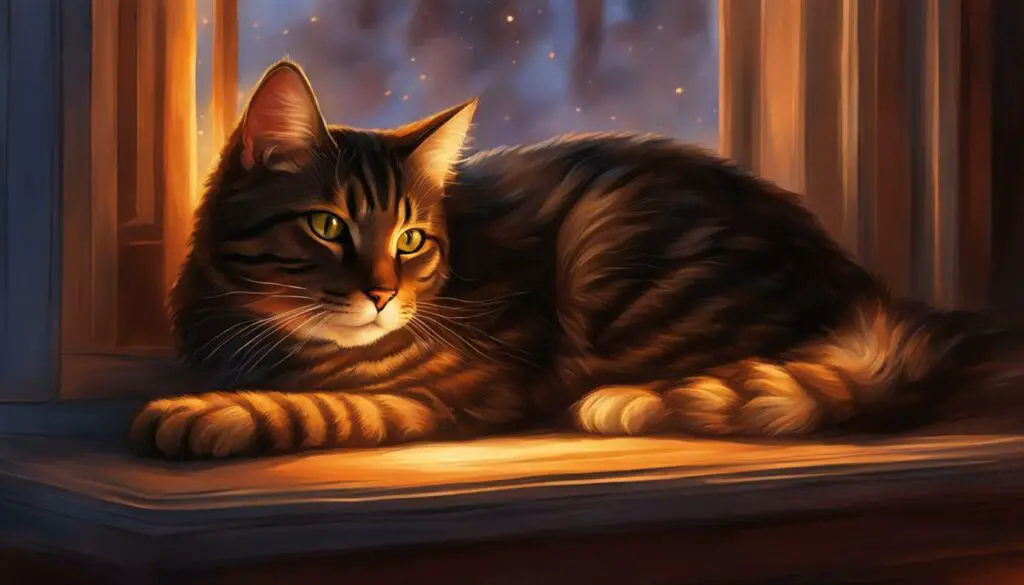
Conclusion
Ensuring the optimal house temperature for cats in winter is essential for their well-being and comfort. By understanding cats’ sensitivity to temperature and providing a warm and cozy environment, you can help your feline friend stay happy and healthy throughout the colder months.
Remember that maintaining a house temperature of around 70 degrees Fahrenheit is ideal for most cats, but factors such as breed, size, and health condition should be taken into consideration. Pay attention to your cat’s behavior and adjust the temperature accordingly.
In addition to providing a warm indoor environment, consider other measures such as a nutritious diet for promoting a healthy winter coat and taking precautions in extreme temperatures. Traveling with your cat during winter requires extra care, so make sure to provide a comfortable and safe journey.
Create a cat-friendly winter environment by offering interactive toys, cozy sleeping areas, and protection from potential hazards. Regular grooming and the use of pet-friendly heating options can also contribute to your cat’s winter comfort.
By following these guidelines, you can ensure that your cat stays cozy and content during the colder months, providing them with the care and attention they deserve.
FAQ
What temperature should I keep my house for my cat during winter?
Most cats will find a temperature of 70 degrees Fahrenheit comfortable during winter. However, a minimum safe temperature indoors for cats is around 50 degrees Fahrenheit to avoid hypothermia.
How can I tell if my cat is too cold?
Signs that your cat may be too cold include curling up tightly, seeking warmth from you more than usual, shivering, and cold paws, ears, and tail.
How can I keep my cat warm indoors during winter?
Maintain a warm house temperature, provide a cozy sleeping area with a soft blanket near a window or heater, and consider investing in a heated cat bed for extra warmth.
Does my cat’s diet affect its ability to stay warm during winter?
Yes, a nutritious diet plays a crucial role in helping your cat develop a thick winter coat for insulation. Consult your veterinarian for recommendations on the best diet and supplements for promoting a healthy winter coat.
Are there any factors that affect a cat’s tolerance to temperature?
Yes, factors such as breed, age, size, and health condition can affect a cat’s ability to tolerate temperature. Long-haired cats generally tolerate cooler temperatures better than short-haired cats, and kittens and older cats require warmer temperatures than adult cats.
What is the ideal winter temperature for cats indoors?
While there is no exact magic number, the ideal winter temperature for cats indoors typically ranges between 60 and 70 degrees Fahrenheit. Factors such as your cat’s breed, size, and health condition should be considered when determining the specific temperature.
How should I adjust the temperature for cats during summer?
Cats generally tolerate warmer temperatures, so a range of 80 to 90 degrees Fahrenheit is suitable for long-haired or overweight cats, while short-haired or slim cats can tolerate temperatures up to 90 degrees Fahrenheit. Ensure proper air circulation and provide cooling options, such as cooling pet beds or access to shaded areas, to help your cat stay comfortable.
How can I help my cat balance its body temperature at home?
Provide high areas where your cat can bask in the sun’s warmth, create warm areas with heated pet beds or blankets on fully tiled floors, and ensure your cat has access to sunlight. Additionally, observe your cat’s behavior and adjust the temperature accordingly.
How can I keep my cat safe in extreme temperatures?
In very cold weather, bring outdoor cats indoors or provide a warm shelter with insulation and blankets. In hot weather, provide shade, ventilation, and ample water to prevent dehydration. Never leave your cat in a car during extreme temperatures.
How can I ensure my cat’s comfort while traveling in winter?
Use a carrier with proper ventilation and insulation, provide a cozy blanket for warmth, and keep the car interior temperature comfortable for your cat. Bring extra supplies, such as food, water, and blankets, and consult with your veterinarian for additional advice specific to your cat’s needs.
How can I create a cat-friendly environment during winter?
Provide interactive toys and scratching posts, offer plenty of cozy spots and bedding options, protect your cat from potential hazards like open flames, regularly groom your cat’s fur, and consider pet-friendly heating options like heated pads or blankets.

